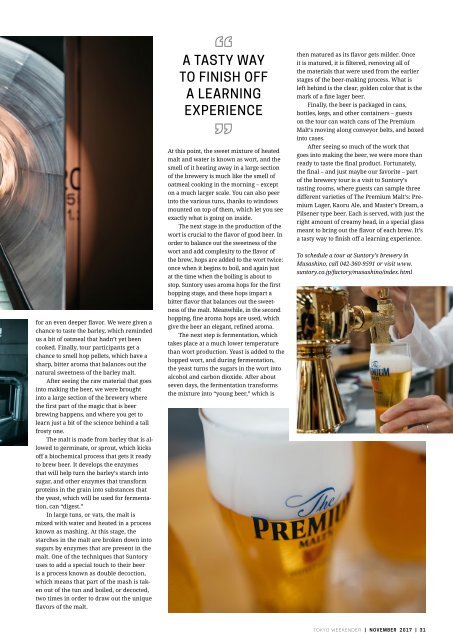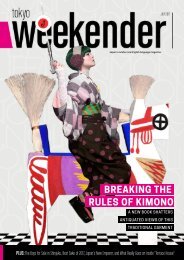Tokyo Weekender - November 2017
Our November issue is out, featuring a jam-packed end-of-year special: 42 Christmas gift shopping ideas and 10 bonenkai spots. Plus: The avant-garde world of butoh dance, Japanese teen prodigies, and a special supplement guide to Akita. Here's where to find a copy around Tokyo: www.tokyoweekender.com/pickup/
Our November issue is out, featuring a jam-packed end-of-year special: 42 Christmas gift shopping ideas and 10 bonenkai spots. Plus: The avant-garde world of butoh dance, Japanese teen prodigies, and a special supplement guide to Akita. Here's where to find a copy around Tokyo: www.tokyoweekender.com/pickup/
You also want an ePaper? Increase the reach of your titles
YUMPU automatically turns print PDFs into web optimized ePapers that Google loves.
for an even deeper flavor. We were given a<br />
chance to taste the barley, which reminded<br />
us a bit of oatmeal that hadn’t yet been<br />
cooked. Finally, tour participants get a<br />
chance to smell hop pellets, which have a<br />
sharp, bitter aroma that balances out the<br />
natural sweetness of the barley malt.<br />
After seeing the raw material that goes<br />
into making the beer, we were brought<br />
into a large section of the brewery where<br />
the first part of the magic that is beer<br />
brewing happens, and where you get to<br />
learn just a bit of the science behind a tall<br />
frosty one.<br />
The malt is made from barley that is allowed<br />
to germinate, or sprout, which kicks<br />
off a biochemical process that gets it ready<br />
to brew beer. It develops the enzymes<br />
that will help turn the barley’s starch into<br />
sugar, and other enzymes that transform<br />
proteins in the grain into substances that<br />
the yeast, which will be used for fermentation,<br />
can “digest.”<br />
In large tuns, or vats, the malt is<br />
mixed with water and heated in a process<br />
known as mashing. At this stage, the<br />
starches in the malt are broken down into<br />
sugars by enzymes that are present in the<br />
malt. One of the techniques that Suntory<br />
uses to add a special touch to their beer<br />
is a process known as double decoction,<br />
which means that part of the mash is taken<br />
out of the tun and boiled, or decocted,<br />
two times in order to draw out the unique<br />
flavors of the malt.<br />
A TASTY WAY<br />
TO FINISH OFF<br />
A LEARNING<br />
EXPERIENCE<br />
At this point, the sweet mixture of heated<br />
malt and water is known as wort, and the<br />
smell of it heating away in a large section<br />
of the brewery is much like the smell of<br />
oatmeal cooking in the morning – except<br />
on a much larger scale. You can also peer<br />
into the various tuns, thanks to windows<br />
mounted on top of them, which let you see<br />
exactly what is going on inside.<br />
The next stage in the production of the<br />
wort is crucial to the flavor of good beer. In<br />
order to balance out the sweetness of the<br />
wort and add complexity to the flavor of<br />
the brew, hops are added to the wort twice:<br />
once when it begins to boil, and again just<br />
at the time when the boiling is about to<br />
stop. Suntory uses aroma hops for the first<br />
hopping stage, and these hops impart a<br />
bitter flavor that balances out the sweetness<br />
of the malt. Meanwhile, in the second<br />
hopping, fine aroma hops are used, which<br />
give the beer an elegant, refined aroma.<br />
The next step is fermentation, which<br />
takes place at a much lower temperature<br />
than wort production. Yeast is added to the<br />
hopped wort, and during fermentation,<br />
the yeast turns the sugars in the wort into<br />
alcohol and carbon dioxide. After about<br />
seven days, the fermentation transforms<br />
the mixture into “young beer,” which is<br />
then matured as its flavor gets milder. Once<br />
it is matured, it is filtered, removing all of<br />
the materials that were used from the earlier<br />
stages of the beer-making process. What is<br />
left behind is the clear, golden color that is the<br />
mark of a fine lager beer.<br />
Finally, the beer is packaged in cans,<br />
bottles, kegs, and other containers – guests<br />
on the tour can watch cans of The Premium<br />
Malt’s moving along conveyor belts, and boxed<br />
into cases.<br />
After seeing so much of the work that<br />
goes into making the beer, we were more than<br />
ready to taste the final product. Fortunately,<br />
the final – and just maybe our favorite – part<br />
of the brewery tour is a visit to Suntory’s<br />
tasting rooms, where guests can sample three<br />
different varieties of The Premium Malt’s: Premium<br />
Lager, Kaoru Ale, and Master’s Dream, a<br />
Pilsener type beer. Each is served, with just the<br />
right amount of creamy head, in a special glass<br />
meant to bring out the flavor of each brew. It’s<br />
a tasty way to finish off a learning experience.<br />
To schedule a tour at Suntory’s brewery in<br />
Musashino, call 042-360-9591 or visit www.<br />
suntory.co.jp/factory/musashino/index.html<br />
TOKYO WEEKENDER | NOVEMBER <strong>2017</strong> | 31
















